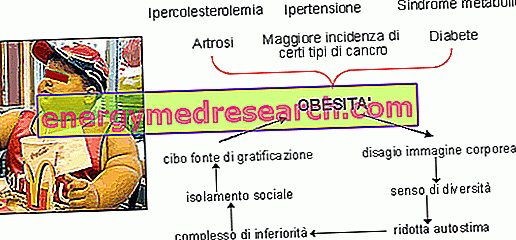Importance of a Proper Diet
Preventive function of the diet for children
A correct diet guarantees the young organism a balanced and healthy growth.
The risks of poor diet in childhood are different:
- Tendency to overweight and obesity, both in the pediatric age and in adulthood
- Tendency to underweight in the pediatric age
- Specific or generalized malnutrition, which can occur as much with the underweight as with the overweight (when consuming only junk foods poor in vitamins and minerals of fruit and vegetables).

It is therefore extremely important for parents to monitor and correct their children's eating habits.
Overweight is obesity in the pediatric age, especially related to the simultaneous presence of two factors:
- Bad diet, characterized by a high consumption of high calorie foods, rich in fats and simple sugars
- Sedentariness and reduction of time dedicated to physical activity.
The first measures to be taken will therefore be aimed at reducing excess weight, paying particular attention to the consumption of sugars (sweets, soft drinks and fruit juices) and encouraging the practice of regular exercise.
Underweight: how harmful can it be for the child and for the future adult?
The underweight can be harmful for growing children.
This is because it often indicates a slowdown or simply a slowness of development.
Although it is not always pathological or dangerous, in some cases the underweight hides a generalized or specific nutritional insufficiency. It is therefore necessary to consult a doctor to rule out malabsorption, even pathological, or any endocrine disorders.
If a significant lack of appetite is evident, it may be helpful to increase the dialogue in the family, eat meals together or, at the very least, consult a psychologist specializing in childhood.
Overweight and Obesity
Importance of overweight and childhood obesity in Italy
Note: The weight and height of the growing subjects is estimated with the method of percentiles, not body mass index (BMI or BMI), instead adopted for adults.
Childhood obesity is certainly the most common nutritional disease in Italy and in other Western countries.
If on the one hand the growing organism makes use of a greater evolutionary / adaptive capacity than the adult one, on the other the child / adolescent can "drag" behind various problems or diseases acquired during development. Obesity is one of them.
It is estimated that approximately 40% of children and 60% of obese adolescents will remain so even in adulthood, with all the negative consequences of the case, which concern:
- The subject's psycho-physical health
- The health costs of the company.
Psychophysical health of overweight obese children
Children with overweight or obesity are more likely to become ill, in adulthood or even in childhood, than:
- Metabolic pathologies
- Type 2 diabetes mellitus
- Hypertriglyceridemia
- Hypercholesterolemia
- Hypertension
- Hyperuricemia and gouty attacks
- Atherosclerosis, thrombosis and cardio-cerebro-vascular events in general (especially in adulthood)
- Eating disorders - DCA (especially from adolescence onwards)
- Bulimia nervosa
- Binge Eating Desorder
- Nervous anorexia
- Secondary or borderline
Social cost of obesity
The social cost of obesity is extremely high.
In certain countries of the European Union it reaches 1% of GDP (gross domestic product) and constitutes 6% of direct health expenditure.
Statistics of childhood obesity
Observing the recent official epidemiological surveys to 2016, it is observed that in the Bel Paese:
- 9.8% of children are affected by obesity
- 20.9% are overweight.
Notes : the areas most affected are in the central-south and in the Campania region, a percentage of overweight is reached equal to 50%.
- Among primary school children (6-10 years):
- 24% are overweight
- 12% show obvious obesity
This data gets worse year after year.
Risk factors
Family
Let's start by pointing out that, for a child, the nutritional status of parents is a very important factor.
- If one parent is obese, the risk of becoming an obese adult increases by 40%
- If both parents are clearly overweight this risk increases up to 80%.
Another extremely indicative element, which offers a concrete, though gruesome, image of the family educational trend, is given by the parents' own evaluation of offspring.
- About 40% of mothers of children with overweight / obesity do NOT believe their child is excessively heavy.
Considerations on childhood obesity
At the origin of this dizzying increase in overweight and childhood obesity could be a genetic predisposition; however, this occurrence corresponds (strictly speaking) to only 1% of cases.
The data on the subject suggest that the influence of bad habits (lifestyle understood as diet and sport), transmitted by parents and the community to children and adolescents, is even more important (99% of cases).
We see some extremely important risk factors for the onset of overweight and childhood obesity
Diet
First of all, keep in mind that:
- Excessive diet in the first two years of life causes
- Increased volume of fat cells (hypertrophy)
- Increase in the number of fat cells (hyperplasia) as adults and, as it will be possible to reduce the size of the cells but not eliminate them, consequently:
- Greater predisposition to obesity
- Difficulty in losing weight or keeping it within limits.
Moreover:
- 11% of children do not have breakfast
- 28% eat breakfast inadequately
- 82% make a snack at school qualitatively NOT correct
- 23-25% of parents declare that their children DO NOT consume fruit and vegetables daily
- Only 2% of all children eat more than 4 servings of fruit and vegetables a day
- 41% drink sugary drinks daily
- 17% consume sugary drinks more than once a day
Physical activity
- Only 10% of children have a level of physical activity recommended for their age
- Only 18% practice sports only an hour a week
- 50% spend more than 2 hours a day in front of the TV or video games and have a TV in the bedroom.

Diet plays an important role in the development of obesity: today, more than ever, many children eat badly, consume too much fat and prefer foods with high calorie density
How to intervene?
Fundamental considerations
What do you need to know before putting children on a diet?
To best treat overweight and obesity in children it is necessary to consider the most important elements (of various kinds).
- Gravidic elements
- They greatly affect the child's overweight attitude: malnutrition in pregnancy, especially in the first and second trimester, gestational diabetes or pre-existing type 2 mellitus increase the chances of childhood obesity.
- Family Items:
- As we said at the beginning of the article, overweight and obesity in young children can increase the risk of developing metabolic and cardio-cerebro-vascular pathologies, both at a young age and in adulthood.
- These pathologies also have a genetic basis - hereditary and family, and tend to be transmitted with the generational shift.
- For this reason, pediatric obesity has a variable level of severity, which increases if one or more first or second degree family members suffer from: obesity, type 2 diabetes mellitus, dyslipidemia, arterial hypertension and heart disease arising before age 55.
- We also need to look for correlated factors of different kinds, such as eating disorders (DCA) and thyroid diseases.
- It seems to have a negative effect, and for this reason it represents a factor to work on, the cultural level of the mother or grandmother who manage the meals.
- Furthermore, contrary to what one might believe, overweight and childhood obesity have a greater prevalence in socially less wealthy situations and with limited economic resources. Unfortunately, this is an element that cannot be changed, but which will have a significant impact on therapy.
- The margin of improvement of children is strictly tied to the life habits and the willingness of parents / grandparents / guardians to apply changes in diet and lifestyle.
- Physiological elements:
- The inadequate weight of the child at birth is of primary importance in the tendency to be overweight
- The same is true for the type of breastfeeding (breastfeeding is considered protective) and the practice of weaning (both early and late forms are inappropriate)
- The growth curve and pubertal development offer very useful data to understand the hormonal structure of the overweight subject, which can evolve more rapidly or slowly (in both cases, these are not positive aspects)
- Lifestyle elements:
- The situation is worsening: the lack of aptitude for physical activity and the high inclination to watch TV and play video games.
- Not even adolescent bad habits, such as smoking, alcohol and drugs, are helpful
- Pathological elements:
- The treatment must also take into consideration the age of onset of excess weight, which is as serious as it is precocious, and any previous unsuccessful attempts at losing weight (especially related to clinical pictures of DCA).
Correct the diet of overweight children
The diet of many children is not only rich in calories, but also unbalanced and full of poor food (junk food) that heavily affect the quality of life and future morbidity.
The correction of these bad eating habits is one of the best interventions to decrease the growth of obesity in our children and adolescents.
Useful dietary advice in children reflects roughly those proposed to the general population.
When we turn to a child we should avoid the term "diet", which is often understood as a kind of punitive action.
If the child eats a lot and is normal weight, it is important not to hinder food intake, since a growing organism actually needs high amounts of nutrients.
In particular:
- The increased need for certain nutrients (calcium, iron, vitamin D and protein) must be satisfied by consuming a wide range of foods; no integration is normally required. Many of these nutrients are contained above all in foods of animal origin and depriving the child of these foods (vegan diet) means creating a nutritional deficit that could interfere with normal development. On the other hand, however, it is not necessary to forget the advantages of fruit and vegetables, often reluctantly consumed by the child. To make these foods more palatable it is possible to use centrifuged and smoothies prepared at home (only if the raw or cooked vegetables are systematically rejected). Instead, we recommend limiting the consumption of juices and industrial fruit juices, as they are too rich in sugar and often poor in vitamins, fiber and mineral salts.
- If the child proves intolerant to milk and dairy products it is important to ensure an adequate supply of calcium through the consumption of water rich in this mineral and foods that contain it in good quantities, such as green vegetables (broccoli, cabbage), legumes ( soy, chickpeas, red beans), nuts and seeds (sesame seeds, flax seeds). Cola-based beverages can negatively affect the calcium balance.
If the child shows poor appetite and is normal weight (not underweight), once he has excluded the pathological causes, it is advisable not to force him to eat more than necessary.
In this way we would in fact alter the child's sense of disenchantment, which once grown could maintain the ability to eat more than necessary.
Useful Tips
Useful tips for the diet of the overweight child
- Clean up the house from junk food (especially snacks, sugary drinks and sweets)
- Keep the child away from food with a very sweet or very salty taste for as long as possible, avoiding introducing them early in the diet.
- Educate the child to eat slowly, as the first digestion takes place in the mouth
- To impose on the child the consumption of an abundant breakfast, according to the rules of the Mediterranean diet (cereals, milk or yogurt, fruit); his health, his mood and his scholastic profit will benefit him
- When preparing the rucksack, also insert a small bottle of water, both to accustom the child to drink frequently, and to avoid the risk of dehydration which in children is higher than in adults
- Do not use food as a means of pressure (eat whatever is on your plate), reward or consolation (if you are good, I buy ice cream)
- Avoid turning food into a punishment or threat (going to bed without dinner)
- Turn off the TV during meals and consume them at set times and places (not where and when it happens)
- Spend more time preparing your child's meals and snacks, using products that are as natural as possible, not packaged; present the food with imagination to satisfy all the senses of the child
- Encourage the child to appreciate the meals provided by the school canteen; if his child does not accept the dish he is given, at the end of the meal he will still be hungry and will be satisfied with snacks, brioches and various snacks.
Food Consumption Frequency
Frequency of consumption of foods in the diet against overweight
| Meat | Preferably 3 times a week, 2 times white (eg rabbit, chicken, turkey) and 1 red (eg beef, horse, veal) |
| Fish | 2 - 3 times a week, fresh or frozen |
| eggs | No more than 3-4 times a week of hen - quality A extra |
| legumes | Dried or frozen at least 3 times a week: broad beans, chickpeas, lentils, peas, beans, soy |
| Cereals | Pasta, polenta, rice, spelled, barley, oat flakes etc., refined or wholemeal |
| vegetable | No less than 14 times a week (every day) fresh in season or frozen, to be used raw or cooked, always choosing different colors |
| Fruit | Preferably 14 times a week (every day) in season, varying in quality and color selection |
| Cheeses | No more than 2 times a week, as a main course |
| Cured meat | No more than once a week prefer lean ham, bresaola, ham without polyphosphates |
| «Weaning food legislation |  | Childhood obesity: prevention " |



